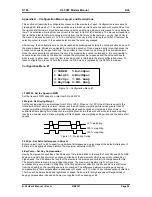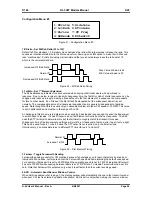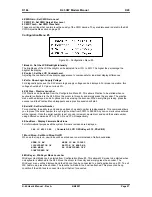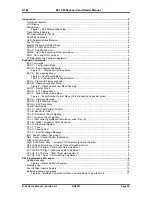
K1EL K45 CW Modem Manual K45
K-45 User’s Manual - Rev A
6/6/2021
Page 19
Preserving Settings
Configuration changes are stored in EEPROM so that they are preserved when power is shut off.
CTL-ALT-DEL Restart
This causes a power on reset of the K45. The current mode is cleared, and all settings are reloaded from
EEPROM. This is equivalent to power cycling the K45.
Paddle Watchdog
The K45 has a built-in output disable that is activated if more than 128 dits or dahs are sent consecutively.
This prevents unattended keying. The output is disabled after 128 consecutive events, but the sidetone
continues to sound allowing you to detect the condition (sidetone needs to be enabled). Paddle watchdog
can be disabled in Configuration Menu #3:PDLwatch.
Running the K45 without a keyboard
The K45 can be operated without a keyboard. It will automatically select the receive window since a transmit
window is not required in paddle entry mode. A quick press of the encoder brings up the message launch
menu (see page 6).
To make configuration changes, press and hold the encoder button down until the configuration menu
appears. Turn the encoder to select a configuration setting and then press the encoder to select that item for
editing. Next, turn the encoder to make changes and then press the encoder button to save the new setting.
To exit configuration editing, press and hold the encoder button just until the menu clears. If the encoder is
held too long it will power down the K45.
Practice and WinKeyer modes are selected from the configuration menu. Practice can be set up using the
encoder and operated with the paddles. To leave Practice, enter the prosign KN on the paddles. This will
take you back to the normal K45 operational screen. Neither paddle nor keyboard is required for WinKeyer
mode. Just select it from the menu and exit WinKeyer Mode by pressing the encoder.
Using a Straight Key with the K45
The K45 can be set up to work with a straight key. Wire the key to an 1/8” stereo plug as shown below. You
must use a stereo connector and the ring must be left unconnected. Once the cable is ready, plug it into the
K45 paddle input jack and then select
Straight
key mode in Configuration Menu #2:KeyrType.
KEY
N/C
Figure 14 – Straight Key Input Connections
Unlike the K44 and other CW keyboards, the K45 fully supports straight key input for all modes. The user
can run Echo and QSO practice from a straight key as well as normal on air transmit. Straight key input will
be displayed in the transmit window just like paddle input would be. Neither straight nor iambic input will be
shown in the Fast Tx View window since that is reserved for type ahead and messages. It’s not possible to
buffer anything while entering letters on a paddle so viewing the transmit window is all that is needed.
When text is entered on a straight key, the status line TX WPM readout will be updated with the user’s
straight key speed. This temporarily changes the transmit speed for keyboard entry as well so that if
someone changes over from straight key to keyboard, the speed will be appropriate. If the user decides to
go back to the default WPM, click the encoder back and forth once, and the keyboard speed will be restored.
Numeric Pad Operation Mode
When desktop space is limited, the K45 can operate with a small numeric keypad. Numeric Keypad
operation is enabled by turning NumPad mode on in Configuration Menu #4:NumPad (see page 27). The
numeric pad has two sets of key functions as determined by the NumLock key. For example, when
NumLock is off pressing 7 will send the number 7, when NumLock is on the Home function is selected. Most
pads have an NumLock LED that shows which set is active. In any case, NUML is flashed on the status line
when NumLock is set to on.






























